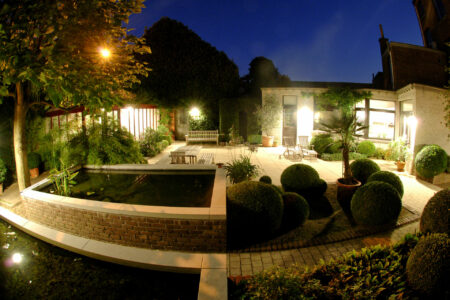The beam angle of LED luminaires and illuminants determines how large the light cone appears in your room. Here you can find out what the bream angle in degrees means and what you should pay attention to when choosing a directional LED light. You will also find a tool to calculate the optimum beam angle for your use case.
Explanation of LED beam angle
LED luminaires and illuminants have both omnidirectional and directional light sources. Omnidirectional spotlights emit their light evenly distributed in all directions. LED spotlights, on the other hand, are directional light sources. They emit their entire luminous flux in only one specific direction.
The beam angle indicates the angle at which the luminous flux passes out of the LED spotlight. Depending on the distance between the lamp and the floor or the illuminated surface, this creates a light cone with a corresponding diameter.
The beam angle has a direct influence on how large the produced light cone appears in the room. You can find the mathematical relationship between beam angle, distance and diameter below:
Earlier halogen spotlights usually had a beam angle of 35°. LED spots were first available with similar beam angles in the range of 30°. With integrated prisms or diffuser lenses, modern LED spotlights are now available with beam angles from as little as 10° up to 120°.
Beam angle and field angle
Besides the beam angle there is also the so-called field angle. In the light circle, the beam angle defines the area where the lamp radiates at least half (50%) of its maximum luminous intensity. The full luminous intensity (100%) is only achieved exactly in the center of the light circle.

The field angle defines the outer area in the light circle where the lamp radiates up to one tenth (10%) of its maximum luminous intensity. Even outside the field angle it is not completely dark, small parts of the luminous intensity are still emitted here as scattered light.
Beam angle and distance
The beam angle determines how large the generated light circle appears on the illuminated object. An important factor here is also the distance between the light source and the illuminated object.
If an LED spotlight is not far away from a wall for example, only a small dotted light circle will be visible. But if you take the spotlight back from the wall, the light circuit becomes larger and larger.
Beam angle and brightness
There is also a direct correlation between the beam angle and the brightness of an LED lamp. The brightness of LED lamps is given in lumens. If we compare two LED spots with an identical light output of 600 lumens, according to the data sheet they seem to have the same brightness.
However, if both spotlights have different beam angles, let’s say 15° and 60°, this puts the perceived brightness into perspective. The spotlight with a beam angle of 60° must illuminate a much larger area with the same light output as the 15° spotlight.
For this reason, the illuminated surface appears larger but also much darker. This is why you always have to choose the beam angle in conjunction with the desired brightness on the surface you want to illuminate.
Which beam angle for which location?
The beam angle is primarily interesting for directional light sources. These include LED spots or LED spotlights and GU10 illuminates. The beam angle should be chosen according to the location or use-case before purchasing the LED lamp. In the living area there are mainly these three lighting applications:
- Basic lighting
- Accent lighting
- Decorative lighting
A beam angle of 120° is a good choice for the basic lighting of a room. For corridors and pathways within a room, a beam angle of 90° is more recommended.
Accent lighting is used to highlight certain areas in a room. This can be a sitting area or a colored wall. Here, the beam angle must be selected individually, depending on the size of the area to be emphasized.
Decorative lighting is often used to highlight certain objects in a room. This can be an art object or a picture. Also here the beam angle depends on the diameter of the object and the distance to the light source.
The beam angle calculator helps you to determine the correct angle.
Beam angle for LED spots
LED spots are available in different variants, for example for ceiling installation or surface mounting. These are offered with many different beam angles. The angle should be selected according to the application as described above.
Beam angle for GU10 LEDs
GU10 LED illuminants are also available with different beam angles. Here not only the beam angle of the illuminant plays a role. The type of the luminaire or the lamp glass where the GU10 lamp is used is also important.
A GU10 lamp with a 120° beam angle would probably be screened with a small opening of the lamp glass. The actual beam angle of that lamp would therefore be smaller and part of the brightness gets lost in the lamp glass.
Meaning of a beam angle of 15°, 60° or 120° degrees
The table gives you an overview of the diameter of the light circle with different beam angles and a ceiling height of 8 feet. For a calculation with your own individual values you can use the online calculator.
| Beam Angle | Diameter of Light Circle |
|---|---|
| 15° | 2.1 feet |
| 30° | 4.3 feet |
| 45° | 6.6 feet |
| 60° | 9.2 feet |
| 90° | 16 feet |
| 120° | 27.7 feet |
Calculate beam angle
The beam angle value sometimes seems to be a bit non-descriptive. Especially due to the influence of the distance between lamp and floor or wall, an estimation is quite difficult. The following formula and the calculator will help you to determine the best fitting beam angle.
Beam angle formula
With the help of the following trigonometric function (angle function) you can calculate the beam angle yourself with all parameters.

- α: Beam angle
- Ø: Diameter of the object or surface to be illuminated
- d: Distance between lamp and object or surface
- arctan: Inverse function of the tangent for angle calculation
Beam angle online calculator
The calculator helps you to calculate the exact beam angle for your scenario. Here you can calculate the direct relationship between the beam angle, diameter of the light circle and the distance to the illuminated object (floor, table, work surface, wall, picture).
In this way you can calculate the optimum beam angle for your application and use it in your purchase decision.
Conclusion: The optical impression is important
The beam angle of an LED spot determines the diameter of the generated light circle on the illuminated surface or object. The ideal beam angle usually depends very individually on the place of use of the lamp and on your individual use-case. This can be determined very well with the beam angle calculator.
Basically, large beam angles of 90° or 120° are well suited for illuminating a room over a large area. Small beam angles of 15° to 35° are a good choice for decorative lighting.






